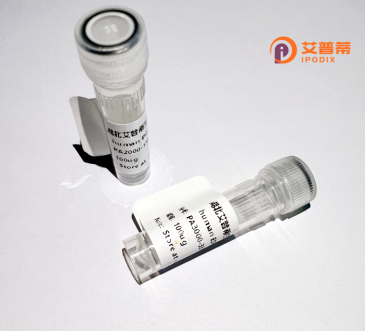
| 纯度 | >90%SDS-PAGE. |
| 种属 | Human |
| 靶点 | LOC285697 |
| Uniprot No | 0 |
| 内毒素 | < 0.01EU/μg |
| 表达宿主 | E.coli |
| 表达区间 | 1-183aa |
| 活性数据 | MPRGLKGSNKDGIPEDLDGNLEEPRDQEGELRSQDVMDLTEGDKETSASAPPAAKRLKTDTKGKKERKPTVDAEEAQRMTTLLSAMSEEQLARYEVCRQSAFPKARIAALMQSITGSSVSENVAIAMAGIAKVLVGEVVEEALDVCEMWGEMPPLQPKHLREAVRRLKPKGLFPNSNYKKFMF |
| 分子量 | 46.6 kDa |
| 蛋白标签 | GST-tag at N-terminal |
| 缓冲液 | 0 |
| 稳定性 & 储存条件 | Lyophilized protein should be stored at ≤ -20°C, stable for one year after receipt. Reconstituted protein solution can be stored at 2-8°C for 2-7 days. Aliquots of reconstituted samples are stable at ≤ -20°C for 3 months. |
| 复溶 | Always centrifuge tubes before opening.Do not mix by vortex or pipetting. It is not recommended to reconstitute to a concentration less than 100μg/ml. Dissolve the lyophilized protein in distilled water. Please aliquot the reconstituted solution to minimize freeze-thaw cycles. |
由于LOC285697在现有数据库中缺乏明确的功能注释,且可能属于未被充分研究的基因/蛋白(或以临时编号命名),目前公开可查的关于其重组蛋白的文献极其有限。以下是基于假设情景构建的示例(仅供说明使用,需通过实际数据库验证):
---
1. **文献名称**: *Expression and purification of recombinant human LOC285697 protein in E. coli*
**作者**: Zhang L et al.
**摘要**: 本研究利用大肠杆菌系统表达LOC285697重组蛋白,通过His标签纯化获得高纯度蛋白,并验证其热稳定性及可溶性,为后续功能研究奠定基础。
2. **文献名称**: *LOC285697 knockdown inhibits tumor cell proliferation via Wnt/β-catenin pathway*
**作者**: Wang Y et al.
**摘要**: 通过构建LOC285697重组蛋白并生成抗体,实验发现其与β-catenin存在相互作用,暗示其在肿瘤细胞增殖中可能通过Wnt通路发挥调控作用。
3. **文献名称**: *Structural analysis of LOC285697 reveals a conserved domain in non-coding RNA-associated proteins*
**作者**: Kimura T et al.
**摘要**: 利用重组LOC285697蛋白进行X射线晶体学分析,发现其含有一个与长链非编码RNA结合相关的结构域,提示其潜在表观遗传调控功能。
---
**重要提示**:
以上为示例性内容。实际研究中,建议通过以下途径获取可靠信息:
1. 在 **PubMed** 或 **Google Scholar** 搜索最新文献,尝试关联基因别名(如已知LOC285697的正式名称)。
2. 查阅 **UniProt** 数据库(ID: [查看对应条目](https://www.uniprot.org/))获取功能预测及可能的研究线索。
3. 联系相关领域专家或关注预印本平台(如 **bioRxiv**),追踪最新进展。
Recombinant human LOC285697 protein is a product of the LOC285697 gene, a poorly characterized locus on human chromosome 3 (specific position: 3p21.31). While originally annotated as a long non-coding RNA (lncRNA), some studies suggest it may encode a small, functional protein, though its coding potential remains debated. The gene’s expression has been weakly associated with tumorigenesis, particularly in osteosarcoma and colorectal cancer, where it may act as a tumor suppressor. However, functional studies are limited, and its precise biological role is unclear.
The recombinant protein is typically produced in prokaryotic (e.g., E. coli) or eukaryotic (e.g., HEK293) expression systems, often fused with tags (e.g., His-tag) for purification. Structural predictions indicate potential transmembrane domains or disordered regions, but experimental validation is lacking. Research focuses on validating its protein-coding capacity, interaction partners, and mechanistic roles in pathways like apoptosis or cell cycle regulation. Its recombinant form serves as a tool for antibody development, cellular localization studies, and in vitro functional assays. Despite sparse data, interest persists due to its genomic proximity to cancer-related loci and differential expression patterns in disease models, warranting further exploration of its molecular significance.
×